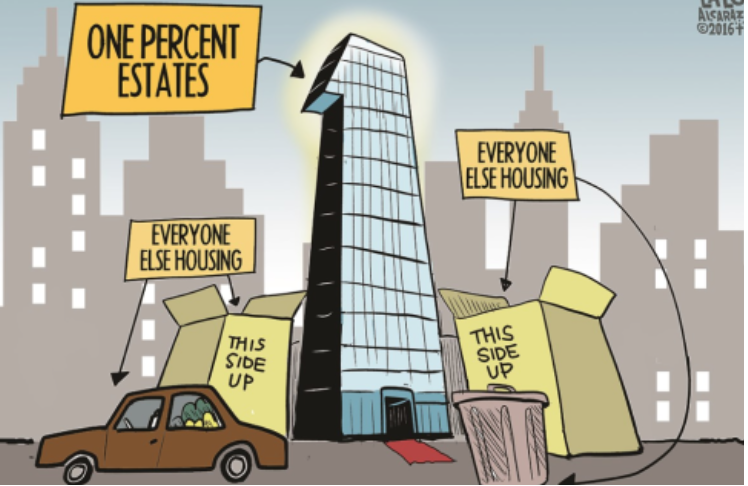CommentsPLATKIN ON PLANNING-You don’t need to be a lobbyist for the real estate industry to realize that the entire country, especially Los Angeles, is in the midst of a housing crisis.
We can see it for what it is, without using this crisis as a pretext for schemes and scams carved out for real estate investors, such as free up-zones and loopholes to dodge public hearings, L.A’s 1986 Proposition U, and the California Environmental Quality Act. A basic plan-monitoring program would quickly dispel the most preposterous of these ruses, that rolling back zoning laws wondrously solves the housing crisis, drives up transit ridership, and reduces Green House Gas emissions.
The housing crisis presents itself to us in at least four different ways:
- Homelessness. The most visible aspect of the housing crisis is increasing homelessness and homeless encampments. While many Angelinos imagine that this is a local problem, calling encampments Garcettivilles, the growth of homelessness is, in fact, a disgrace throughout the entire United States.
- Overcrowding. While overcrowding is increasing across the entire country, according to the Los Angeles Times, Los Angeles and Orange Counties have some the highest rates of overcrowding in the United States.
- Rent-gouging. According to the Business Insider, 90 percent of the 100 largest urban areas in the United State experienced significant rent increases from 2017 to 2018. As for Southern California, “the rental market is going completely nuts. The area has five cities on the above list: Los Angeles, San Diego, Santa Ana, Anaheim, and Long Beach. In four of them, rents have jumped between 10% and 15% from a year ago.”
- Out-migration of people who can no longer afford to live in California. Over the past decade over 600,000 people left California, most of whom were poorer and less educated than those who stayed. At the same time, California experienced a net increase of 50,000 new residents with a bachelors or advanced degree.
Roots of the Housing Crisis: The housing crisis did not mysteriously appear one day. It is the result of at least 12 reversible public policy decisions.
- Elimination of HUD (Federal Department of Housing and Urban Development) public housing programs. Beginning with the Nixon Administration (1969 -1974), the Federal Government began a long-term program to eliminate HUD’s public housing programs. In 2019 the remnants of these programs are now on the Trump Administration’s chopping block.
- Termination of HUD-subsidized affordable housing programs, especially 221.d.3 and 236. These dismantled affordable housing programs have produced many successful projects in Los Angeles, especially in Chinatown, Little Tokyo, and Bunker Hill. Unfortunately, the covenants that that restrict these rental units to low-income tenants are now expiring. As these changes unfold, thousands of these well-located affordable units will switch over to high-income tenants.
- Underfunding of Section 8 housing. In Los Angeles 600,000 people want Section 8 housing, but because of funding cutbacks, only 400 people per year move into Section 8 housing.
- Dissolving Community Redevelopment Agencies. In 2011 California had over 400 redevelopment agencies, but the Legislature’s decision to dissolve them in early 2012 led to their demise, including their role in funding affordable housing projects.
- Freezing the Federal minimum wage at $7.75 per hour, far below inflation and the cost of living, has forced millions into such poverty that they can no longer afford a decent place to live. Had the U.S. minimum wage been indexed to inflation, it would now be $11 per hour, still less than a living wage. Had it been indexed to increases in productivity, it would be a living wage of $21 per hour, enough to lift many people out of homelessness and over-crowded houses and apartments.
- Substituting token affordable housing density bonuses, offered through SB 1818 and TOC Guidelines, for dismantled Federal and State housing programs, and then not inspecting affordable housing sites to certify that pledged affordable units exist and their occupants are, in fact, qualified low-income renters.
- Restricting Los Angeles’ rent stabilization law to housing built before 1978, in buildings with five or more units. By excluding housing that has been constructed within the past 40 years, or single-family, duplex, and four-plex units from rent control, rent increases and evictions have soared.
- Spreading data-free narratives that homelessness, rent-gouging, and overcrowding result from zoning laws, not broad shifts in public policy, mortgage rates, tax legislation, and the business cycle. Obvious questions, such as explaining how a constant, zoning, can cause enormous fluctuations in the cost of housing and the rate of housing construction, remain unasked and unanswered. If these questions were posed, the plunge in housing prices and production in the 1990s and during the Great Recession would be a conundrum for those genuinely concerned about resolving the housing crisis.
- Ignoring the end of raw land in Los Angeles as a leading factor responsible for LA’s reduced middle class housing production. Unlike the urban edge, where raw land still exists, in Los Angeles new development – almost entirely expensive -- depends on the demolition of existing buildings, usually matched with residential evictions, to secure building sites for highly profitable in-fill development.

- Failing to compile easily accessible housing databases. LA’s Housing and Community Investment Department (HCID) has failed to assist prospective tenants by maintaining an easily accessible list of affordable units, whether created through Section 8, SB 1818, or TOC Guidelines. Likewise, they have also not assembled a list of qualified low-income renters that landlords can refer to when screening applicants for their affordable units.
- Slow-walking the formal planning and monitoring processes, creating unnecessary barriers to determine where under-utilized zoning is available for by-right housing construction, where local infrastructure and public services have sufficient capacity to serve more buildings and people, and where the greatest demand for affordable housing exists or is forecast.
- Claiming the market can meet the need for affordable housing by building expensive housing, without any evidence to back up this totally specious claim. Other than a protracted real estate crash that cuts deeper and lasts longer than the 2008-2013 Great Recession, LA’s new, expensive apartments will remain expensive for the foreseeable future and continue to pull up rents in nearby neighborhoods.
Like climate change, the housing crisis is manmade, and we know who the perpetrators are and what they did.
(Dick Platkin is a former Los Angeles city planner, who reports of local planning controversies for CityWatchLA. Please send any questions, comments, or corrections to [email protected].) Prepped for CityWatch by Linda Abrams.

















